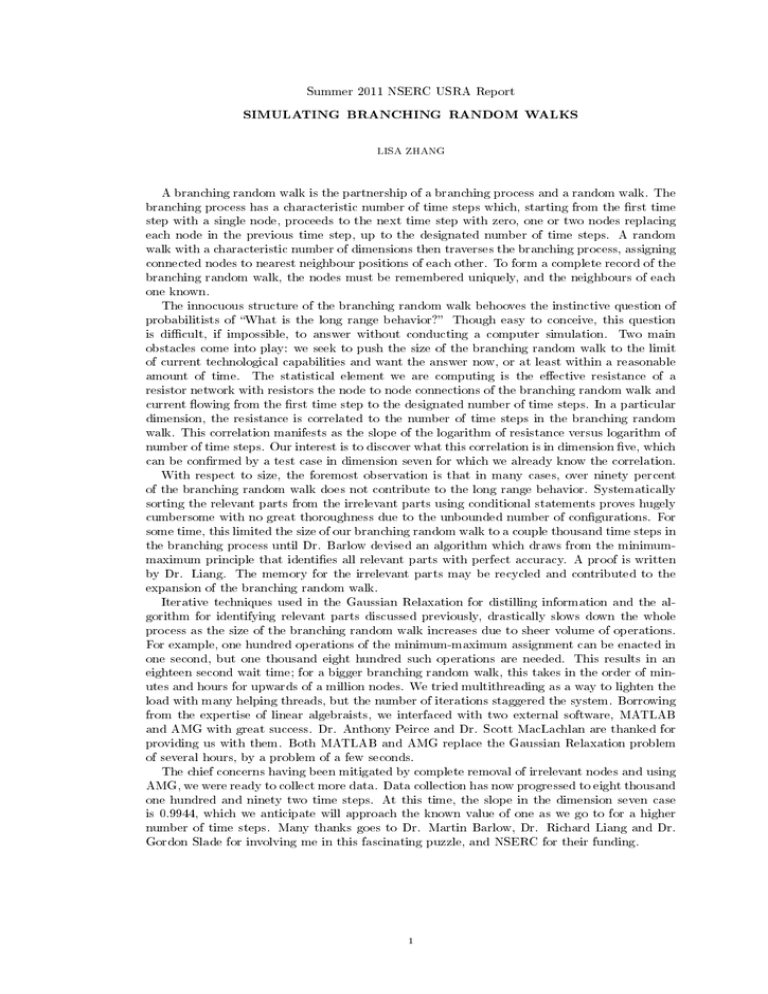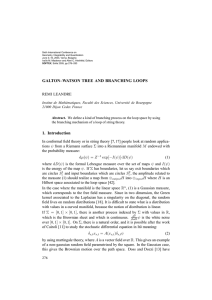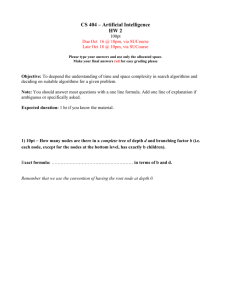Summer 2011 NSERC USRA Report SIMULATING BRANCHING RANDOM WALKS
advertisement

Summer 2011 NSERC USRA Report SIMULATING BRANCHING RANDOM WALKS LISA ZHANG A branching random walk is the partnership of a branching process and a random walk. The branching process has a characteristic number of time steps which, starting from the rst time step with a single node, proceeds to the next time step with zero, one or two nodes replacing each node in the previous time step, up to the designated number of time steps. A random walk with a characteristic number of dimensions then traverses the branching process, assigning connected nodes to nearest neighbour positions of each other. To form a complete record of the branching random walk, the nodes must be remembered uniquely, and the neighbours of each one known. The innocuous structure of the branching random walk behooves the instinctive question of probabilitists of What is the long range behavior? Though easy to conceive, this question is dicult, if impossible, to answer without conducting a computer simulation. Two main obstacles come into play: we seek to push the size of the branching random walk to the limit of current technological capabilities and want the answer now, or at least within a reasonable amount of time. The statistical element we are computing is the eective resistance of a resistor network with resistors the node to node connections of the branching random walk and current owing from the rst time step to the designated number of time steps. In a particular dimension, the resistance is correlated to the number of time steps in the branching random walk. This correlation manifests as the slope of the logarithm of resistance versus logarithm of number of time steps. Our interest is to discover what this correlation is in dimension ve, which can be conrmed by a test case in dimension seven for which we already know the correlation. With respect to size, the foremost observation is that in many cases, over ninety percent of the branching random walk does not contribute to the long range behavior. Systematically sorting the relevant parts from the irrelevant parts using conditional statements proves hugely cumbersome with no great thoroughness due to the unbounded number of congurations. For some time, this limited the size of our branching random walk to a couple thousand time steps in the branching process until Dr. Barlow devised an algorithm which draws from the minimummaximum principle that identies all relevant parts with perfect accuracy. A proof is written by Dr. Liang. The memory for the irrelevant parts may be recycled and contributed to the expansion of the branching random walk. Iterative techniques used in the Gaussian Relaxation for distilling information and the algorithm for identifying relevant parts discussed previously, drastically slows down the whole process as the size of the branching random walk increases due to sheer volume of operations. For example, one hundred operations of the minimum-maximum assignment can be enacted in one second, but one thousand eight hundred such operations are needed. This results in an eighteen second wait time; for a bigger branching random walk, this takes in the order of minutes and hours for upwards of a million nodes. We tried multithreading as a way to lighten the load with many helping threads, but the number of iterations staggered the system. Borrowing from the expertise of linear algebraists, we interfaced with two external software, MATLAB and AMG with great success. Dr. Anthony Peirce and Dr. Scott MacLachlan are thanked for providing us with them. Both MATLAB and AMG replace the Gaussian Relaxation problem of several hours, by a problem of a few seconds. The chief concerns having been mitigated by complete removal of irrelevant nodes and using AMG, we were ready to collect more data. Data collection has now progressed to eight thousand one hundred and ninety two time steps. At this time, the slope in the dimension seven case is 0.9944, which we anticipate will approach the known value of one as we go to for a higher number of time steps. Many thanks goes to Dr. Martin Barlow, Dr. Richard Liang and Dr. Gordon Slade for involving me in this fascinating puzzle, and NSERC for their funding. 1





![Branching Out: An Introduction to Family History [pptx , 2.3 MB]](http://s2.studylib.net/store/data/005232376_1-8bb1ea3bff509441ce8b545117622545-300x300.png)
